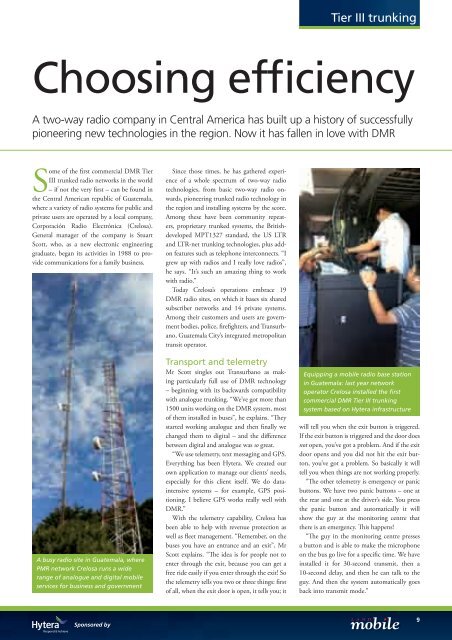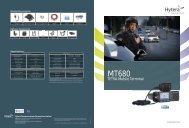G S Kok, Hytera's vice-president for subscriber terminals, talks to ...
G S Kok, Hytera's vice-president for subscriber terminals, talks to ...
G S Kok, Hytera's vice-president for subscriber terminals, talks to ...
You also want an ePaper? Increase the reach of your titles
YUMPU automatically turns print PDFs into web optimized ePapers that Google loves.
Tier III trunkingChoosing efficiencyA two-way radio company in Central America has built up a his<strong>to</strong>ry of successfullypioneering new technologies in the region. Now it has fallen in love with DMRSome of the first commercial DMR TierIII trunked radio networks in the world– if not the very first – can be found inthe Central American republic of Guatemala,where a variety of radio systems <strong>for</strong> public andprivate users are operated by a local company,Corporación Radio Electrónica (Crelosa).General manager of the company is StuartScott, who, as a new electronic engineeringgraduate, began its activities in 1988 <strong>to</strong> providecommunications <strong>for</strong> a family business.A busy radio site in Guatemala, wherePMR network Crelosa runs a widerange of analogue and digital mobileser<strong>vice</strong>s <strong>for</strong> business and governmentSince those times, he has gathered experienceof a whole spectrum of two-way radiotechnologies, from basic two-way radio onwards,pioneering trunked radio technology inthe region and installing systems by the score.Among these have been community repeaters,proprietary trunked systems, the BritishdevelopedMPT1327 standard, the US LTRand LTR-net trunking technologies, plus addonfeatures such as telephone interconnects. “Igrew up with radios and I really love radios”,he says. “It’s such an amazing thing <strong>to</strong> workwith radio.”Today Crelosa’s operations embrace 19DMR radio sites, on which it bases six shared<strong>subscriber</strong> networks and 14 private systems.Among their cus<strong>to</strong>mers and users are governmentbodies, police, firefighters, and Transurbano,Guatemala City’s integrated metropolitantransit opera<strong>to</strong>r.Transport and telemetryMr Scott singles out Transurbano as makingparticularly full use of DMR technology– beginning with its backwards compatibilitywith analogue trunking. “We’ve got more than1500 units working on the DMR system, mos<strong>to</strong>f them installed in buses”, he explains. “Theystarted working analogue and then finally wechanged them <strong>to</strong> digital – and the differencebetween digital and analogue was so great.“We use telemetry, text messaging and GPS.Everything has been Hytera. We created ourown application <strong>to</strong> manage our clients’ needs,especially <strong>for</strong> this client itself. We do dataintensivesystems – <strong>for</strong> example, GPS positioning.I believe GPS works really well withDMR.”With the telemetry capability, Crelosa hasbeen able <strong>to</strong> help with revenue protection aswell as fleet management. “Remember, on thebuses you have an entrance and an exit”, MrScott explains. “The idea is <strong>for</strong> people not <strong>to</strong>enter through the exit, because you can get afree ride easily if you enter through the exit! Sothe telemetry tells you two or three things: firs<strong>to</strong>f all, when the exit door is open, it tells you; itEquipping a mobile radio base stationin Guatemala: last year networkopera<strong>to</strong>r Crelosa installed the firstcommercial DMR Tier III trunkingsystem based on Hytera infrastructurewill tell you when the exit but<strong>to</strong>n is triggered.If the exit but<strong>to</strong>n is triggered and the door doesnot open, you’ve got a problem. And if the exitdoor opens and you did not hit the exit but<strong>to</strong>n,you’ve got a problem. So basically it willtell you when things are not working properly.“The other telemetry is emergency or panicbut<strong>to</strong>ns. We have two panic but<strong>to</strong>ns – one atthe rear and one at the driver’s side. You pressthe panic but<strong>to</strong>n and au<strong>to</strong>matically it willshow the guy at the moni<strong>to</strong>ring centre thatthere is an emergency. This happens!“The guy in the moni<strong>to</strong>ring centre pressesa but<strong>to</strong>n and is able <strong>to</strong> make the microphoneon the bus go live <strong>for</strong> a specific time. We haveinstalled it <strong>for</strong> 30-second transmit, then a10-second delay, and then he can talk <strong>to</strong> theguy. And then the system au<strong>to</strong>matically goesback in<strong>to</strong> transmit mode.”Sponsored by9




